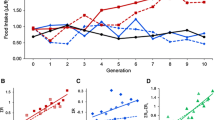Abstract
The adaptation to glucose and starch foods insix species, D. melanogaster, D.virilis, D. saltans, D. funebris,D. levanonensis and D. americana, wasstudied by measuring productivity. D.melanogaster and D. virilis adapted more to thestarch environment than to the glucose environment,while D. saltans adapted more to the glucoseenvironment than to the starch environment. D.funebris, D. levanonensis, and D. americana did not distinctlyadapt to either environment. In addition, the regulationof amylase in the six species was investigated bymeasuring the levels of amylase activity with glucoseand starch food environments. The levels of amylaseactivity in D. levanonensis and D.saltans were substantially low, indicating thatthese species cannot utilize starch as a carbon source.The starch-adapted species, D. melanogaster and D.virilis, showed higher levels of amylase activitywith the starch environment and higher inducibility.These results suggest that changing the regulation ofamylase is important for the adaptation to a starch environment inDrosophila.
Similar content being viewed by others
LITERATURE CITED
Abe, K. (1958). Genetical and biochemical studies on amylase in Drosophila melanogaster. Jap. J. Genet. 33:138.
Doane, W.W. (1967). Quantitation of amylases in Drosophila separated by acrylamide gel electrophoresis. J. Exp. Zool. 164:363.
Doane, W. W. (1969a). Amylase variants in Drosophila melanogaster. Linkage studies and characterization of enzyme extracts. J. Exp. Zool. 171:321.
Doane, W. W. (1969b). Drosophila amylase and problems in cellular differentiation. In Hanley, E. W. (ed.), RNA in Development, University of Utah Press, Salt Lake City.
Eguchi, Y., and Matsuo, Y. (1999). Divergence of the regulation of α-amylase activity in Drosophila melanogaster, Drosophila funebris, and Drosophila saltans. Biochem. Genet. 37:41.
Hickey, D. A., and Benkel, B. F. (1982). Regulation of amylase activity in Drosophila melanogaster. Effects of dietary carbohydrate. Biochem. Genet. 20:1117.
Hickey, D.A., Benkel, K. I., Fong, Y., and Benkel, B. F. (1994). A Drosophila gene promoter is subject to glucose repression in yeast cells. Proc. Natl. Acad. Sci. USA 91:11109.
Hoorn, A. J. W., and Scharloo, W. (1978). The functional significance of amylase polymorphism in Drosophila melanogaster. V. The effect of food components on amylase and α-glucosidase activity. Genetica 49:181.
Hoorn, A. J. W., and Scharloo, W. (1981). The functional significance of amylase polymorphism in Drosophila melanogaster. VI. Duration of development and amylase activity in larvae when starch is a limiting factor. Genetica 55:195.
Inomata, N., Kanda, K., Cariou, M. L., Tachida, H., and Yamazaki, T. (1995). Evolution of the response patterns to dietary carbohydrates and the developmental differentiation of gene expression of α-amylase in Drosophila. J. Mol. Evol. 41:1076.
Magoulas, C., Bally-Cuif, L., Loverre-Chyurlia, A., Benkel, B., and Hickey, D. (1993a). A short 5′-flanking region mediates glucose repression of amylase gene expression in Drosophila melanogaster. Genetics 134:507.
Magoulas, C., Loverre-Chyurlia, A., Abukashawa, S., Bally-Cuif, L., and Hickey, D. (1993b). Functional conservation of a glucose-repressible amylase gene promoter from Drosophila virilis in Drosophila melanogaster. J. Mol. Evol. 36:234.
Matsuo, Y., and Yamazaki, T. (1984). Genetic analysis of natural populations of Drosophila melanogaster in Japan. IV. Natural selection on the inducibility, but not on the structural genes, of amylase loci. Genetics 108:879.
Matsuo, Y., and Yamazaki, T. (1986). Genetic analysis of natural populations of Drosophila melanogaster in Japan. VI. Differential regulation of duplicated amylase loci and degree of dominance of amylase activity in different environments. Jap. J. Genet. 61:543.
Matsuo, Y., and Yamazaki, T. (1997). Genetic factors on the second and third chromosomes responsible for the variation of amylase activity and inducibility in Drosophila melanogaster. Genet. Res. 70:97.
Milanovic, M., and Andjelkovic, M. (1992). Adaptive significance of amylase polymorphism in Drosophila. VI. Properties of two amylase variants and the effect of food components on amylase activity in Drosophila subobscura. Comp. Biochem. Phys. 101B:611.
Milanovic, M., and Andjelkovic, M. (1993). Biochemical and genetic diversity of alpha-amylase in Drosophila. Arch. Biol. Sci. Belgrade 45:63.
Milanovic, M., Stamenkovic-Bojic, G., and Andjelkovic, M. (1989). Adaptive significance of amylase polymorphism in Drosophila. IV. A comparative study of biochemical poperties of the alpha-amylase in Drosophila melanogaster, Drosophila hydei, Drosophila subobscura and Drosophila busckii. Comp. Biochem. Phys. 93B:629.
Powell, J. R., and Amato, G. D. (1984). Population genetics of Drosophila amylase. V. Genetic background and selection on different carbohydrates. Genetics 106:625.
Powell, J. R., and Andjelkovic, M. (1983). Population genetics of Drosophila amylase. IV. Selection in laboratory populations maintained on different carbohydrates. Genetics 103:675.
Powell, J. L., and Lichtenfels, J. M. (1979). Population genetics of Drosophila amylase. I. Genetic control of tissue-specific expression in Drosophila pseudoobscura. Genetics 92:603.
Shibata, H., and Yamazaki, T. (1994). A comparative study of the enzymological features of α-amylase in the Drosophila melanogaster species subgroup. Jap. J. Genet. 69:251.
Stojilkovic, V., Milanovic, M., Milosevic, M., Andjelkovic, M., and Marinkovic, D. (1995). Adaptive significance of amylase polymorphism in Drosophila. X. Analysis of alpha-amylase activity of two amylase variants in individual Drosophila subobscura flies. Jap. J. Genet. 70:487.
Tejima, T., and Ohba, S. (1981). Genetic regulation of amylase activity in Drosophila virilis. I. Activity variation among laboratory strains. Jap. J. Genet. 56:457.
Yamazaki, T. (1984). Measurement of fitness and its components in six laboratory strains of Drosophila melanogaster. Genetics 108:201.
Yamazaki, T., and Matsuo, Y. (1984). Genetic analysis of natural populations of Drosophila melanogaster in Japan. III. Genetic variability of inducing factors of amylase and fitness. Genetics 108:223.
Rights and permissions
About this article
Cite this article
Fujimoto, J., Kanou, C., Eguchi, Y. et al. Adaptation to a Starch Environment and Regulation of alpha-Amylase in Drosophila. Biochem Genet 37, 53–62 (1999). https://doi.org/10.1023/A:1018766017509
Issue Date:
DOI: https://doi.org/10.1023/A:1018766017509




